San Carlo Borromeo is a Baroque, Roman Catholic church located on Corso Giovecca #191, a block east of the Castello Estense in Ferrara, region of Emilia-Romagna, Italy.
Contents

San Carlo Borromeo is a Baroque, Roman Catholic church located on Corso Giovecca #191, a block east of the Castello Estense in Ferrara, region of Emilia-Romagna, Italy.

Construction of this church took place from 1612-1623, at the site of a chapel dedicated to Saint Filippo e Giacomo, designed by Alberto Schiatti, for the hospital of Santa Anna, which once extended parallel to the facade. The San Carlo church was designed by Giovanni Battista Aleotti, commissioned by Cardinal Carlo Emmanuele Pio. [1]
The earthquake of 2012 caused closure of the church. Restoration of the facade was recently patronized by the Fondazione Cassa di Risparmio di Ferrara. [2] By 2013, reinforcement of the roof was complete. [3]
The facade is decorated by emotive statues of saints and two angels holding a heraldic shield. The angels were sculpted by Angelo Putti, and some have attributed all the statues. Behind the facade is an oval layout with two lateral chapels. The apse contain wooden choir stalls.

The nave has stucco statues of the four doctors of the church: Augustine, Gregory the Great, Jerome, and Ambrose by an 18th-century sculptors of the Venetian-school. [4]
The ceiling was frescoed in 1674 by Giuseppe Avanzi with collaboration of the quadraturist Giuseppe Menegatti. [5]
In the center oval, Avanzi painted the Glory of the Virgin with Saints Maurelio and Carlo Borromeo. The lunette over the entrance has a San Carlo painted by Antonio Bonfanti. [6]

An inventory from 1773 noted to the right of the main altar is the altarpiece of the Virgin and Saints George, Maurelio, and Dominic by Domenico, son of Tintoretto. The four paintings of the Life of the St Carlo were painted by Carlo Borfatti. [7]

Sebastiano Conca was an Italian painter.

San Martino ai Monti, officially known as Santi Silvestro e Martino ai Monti, is a minor basilica in Rome, Italy, in the Rione Monti neighbourhood. It is located near the edge of the Parco del Colle Oppio, near the corner of Via Equizia and Viale del Monte Oppio, about five to six blocks south of Santa Maria Maggiore.
The School of Ferrara was a group of painters which flourished in the Duchy of Ferrara during the Renaissance. Ferrara was ruled by the Este family, well known for its patronage of the arts. Patronage was extended with the ascent of Ercole d'Este I in 1470, and the family continued in power till Alfonso II, Ercole's great-grandson, died without an heir in 1597. The duchy was then occupied in succession by Papal and Austrian forces. The school evolved styles of painting that appeared to blend influences from Mantua, Venice, Lombardy, Bologna, and Florence.
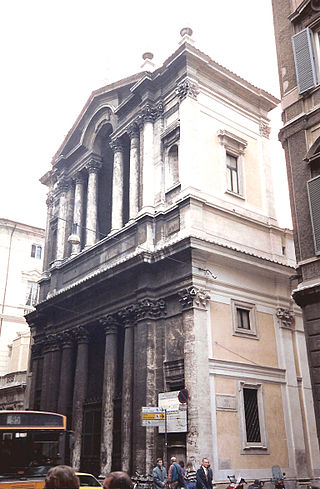
Santa Maria in Via Lata is a church on the Via del Corso, in Rome, Italy. It stands diagonal from the church of San Marcello al Corso.
Maurelio Scanavini or Scannavini was an Italian painter of the Baroque period, mainly active in Ferrara.

Antonio Randa was an Italian painter of the classicist period, active in Ferrara, Modena, Rovigo, Florence, Comacchio and his native Bologna.

The Archdiocese of Ferrara-Comacchio is a Latin Church archdiocese of the Catholic Church. It has existed since 1986, when the diocese of Comacchio was combined with the historical archdiocese of Ferrara. It is a suffragan of the archdiocese of Bologna.

The Church of San Marco in San Girolamo is a baroque parish church in Vicenza, northern Italy, built in the 18th century by the Discalced Carmelites. It houses various artworks by artists of the early 18th century from Veneto. The sacristy preserves its original furniture of the same period.
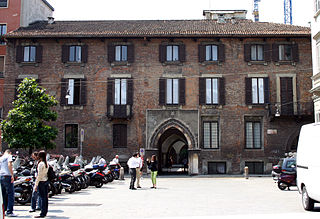
Palazzo Borromeo is a 14th-century building located at piazza Borromeo 12 in Milan, region of Lombardy, Italy. It was built as the home and business headquarters of the Borromeo family, merchant-bankers from Tuscany. Some of the building complex was badly damaged during World War II in Allied bombings of 1943 but was reconstructed and restored to its 15th-century appearance. It contains an important fresco cycle from the 1440s and is one of the finest examples of a Milanese patrician palace from the early Renaissance.

Santa Lucia is a Baroque-style Roman Catholic church located on Strada Cavour in central Parma, region of Emilia Romagna, Italy.
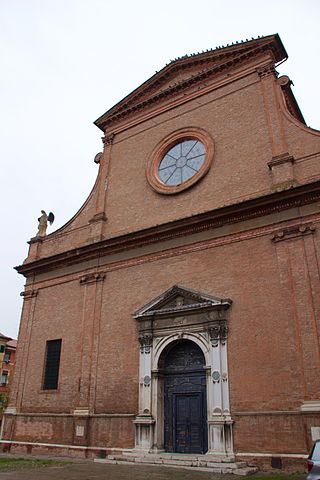
Santa Maria in Vado is a church located on Via Borgovado number 3 in Ferrara, Region of Emilia-Romagna, Italy.

Jacopo Alessandro Calvi was an Italian painter and art critic who painted sacred and historical subjects in a late-Baroque style.

The Church of the Gesù of Ferrara is a Roman Catholic church, erected by the Jesuit order, located on piazzetta Torquato Tasso in Via Borgoleoni #56 in Ferrara, Region of Emilia-Romagna, Italy

The Church of the Theatines (Teatini), also known as Santa Maria della Pietà is a Roman Catholic, Baroque-style church and monastery located on Corso della Giovecca, in central Ferrara, region of Emilia-Romagna, Italy.

San Giuliano is a small Gothic-style, Roman Catholic church located on the Piazzetta delle Castello on the southwest corner of the Castello Estense in Ferrara, region of Emilia-Romagna, Italy.
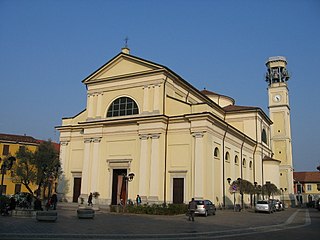
The Church of Saint Bartholomew is the cathedral and the oldest parish in Brugherio, Italy. It houses relics of the three Magi. It is characterised by its relatively high bell tower measuring 36.8 metres (121 ft).

Ferrara Charterhouse, of which the present Church of San Cristoforo alla Certosa was previously the monastic church, is a former charterhouse or Carthusian monastery built in Renaissance style, located on Piazza Borso 50 in Ferrara, Region of Emilia-Romagna, Italy. The monastery was suppressed in the time of Napoleon, but the church was reconsecrated in 1813 and remains in use. The site also accommodates a large municipal cemetery, which was established in 1813.
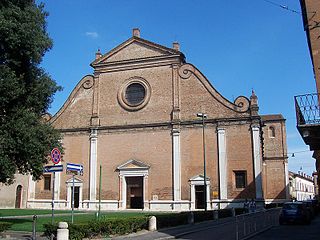
San Francesco is a late-Renaissance, Roman Catholic minor basilica church located on via Terranuova in Ferrara, Emilia-Romagna, Italy.
Andrea Pasqualino Marini was an Italian painter active in the Marche region in a late-Baroque style.

Antonio Mongitore was a Sicilian presbyter, historian and writer, known for his works about the history of Sicily. He was also canon of the cathedral chapter of Palermo.